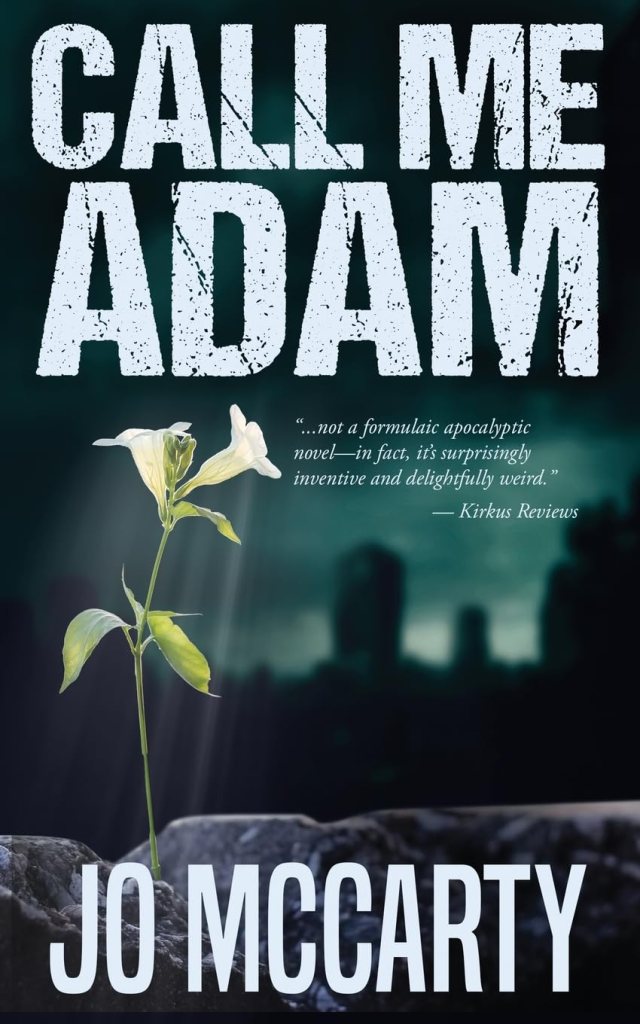

Call Me Adam
Jo McCarty
Crazy Pages Publishing Co (2024)
ISBN: 978-1941175019
Reviewed by Terri Stepek for Reader Views (05/2024)
I read so many books that I get excited when a novel busts through genre norms. Well, this one certainly has. “Call Me Adam,” the debut novel of Jo McCarty, provides readers with the unexpected mash-up of post-apocalyptic and literary fiction. I never saw this one coming.
Reading the book blurb, I expected a slightly deeper than usual post-apocalyptic read. I did not expect the depth of character, the dark inner struggles, or the deeply damaged main characters I found. Louie is a guy who spent his pre-disaster life flying under the radar to avoid the constant bullying his small town loved to heap on him. He’s a bit of a Momma’s boy and prefers his own company to that of others. When his mother dies of COVID, he has nothing left to live for and becomes suicidal. You could even call him an expert at suicide, though he’s never successful. He has no idea why, but in this process he’s discovered that he can’t die. Much to his dismay.
After dozens of deaths, Louie was his own personal unsolved mystery. (pg 13)
Katherine is a big city girl with big city dreams. She is not interested in becoming a soccer mom (or a mom at all). Her desires are bigger and more… worldly than that. She is not narcissistic but is very self-centered and inwardly focused. As civilization falls quickly to a biohazard post-COVID, Katherine doesn’t seem to have much worth living for either.
These guys are not exactly who one would pick to repopulate the decimated world.
Through a bizarre paranormal twist, Katherine in New York and Louie in Michigan begin to realize that their nightly dreams are connected. They spend each night walking and talking in Louie’s lush garden, an interesting shadowing of Adam and Eve. On a whim, Katherine decides to take the chance and travel to Michigan, hoping to combine forces with Louie.
“There’s this garden. It’s all hot in the sun, and there are rows and rows of leafy greens. And there’s this big wall of white trellises with giant cucumbers growing on them. They’re so heavy with cucumbers and big vines that the wall of them is falling back against a fence. I think I’ve dreamed about it every night this week. …Last night there was a man with me. I’ve seen him before, but not his face. I can hear a baby crying on the porch.” (pg 130)
In your standard formulaic end-of-the-world trope, this is when we would discover the zombies, werewolves, or bands of survivalists bent on killing anyone not willing to band with them. But that’s not the state of the world in this novel. While there is some trouble in Katherine’s trip, it’s not quite what one might expect if you’ve read any apocalyptic reads.
While the main characters have their own closets full of personal demons, the secondary characters are a mixed bag of diverse yet genuine personalities. From a lonely state cop to a sassy teenage girl, the secondary characters play vital roles in this character-driven story. Katherine and Louie face intense conflict, both physically and mentally as they fight to maintain their place and possessions in the newly fallen world and as they struggle with the very internal conflicts that made them who they are. This creates a storyline that is often more inwardly focused on the mental states of the two protagonists than on the very act of survival, reminding the reader that this is not your father’s post-apocalypse read.
I personally struggled a bit, especially with Katherine’s personality. While she has a certain strength, she doesn’t show it often and makes rash and/or foolish decisions. Since I’m the kind of reader who prefers a strong, intelligent, trustworthy hero-type of protagonist, it’s not unusual for me to have trouble bonding with characters I see as weaker. Louie also has a certain strength as well as a fair amount of common sense. He’s also more likely to plan ahead and think of others. But how strong can he be when he tries to kill himself every night for months?? Are these really the damaged people I see as humanity’s hope?
She would die in the pandemic after all, but her sickness was apathy. (pg 251)
In the author’s literary wisdom, there is, indeed, something more within these characters, making this a remarkable story regardless of which genre you believe this book belongs to. Readers will see personal growth in the characters, as well as attributes they’re only beginning to realize they possess. As with most “heroes,” they’re not really the strongest, bravest, or even the smartest. They’re just the people caught in a situation not of their choosing, at a certain moment in time when someone needs to stand up and stop further violence, destruction, or death.
I found “Call Me Adam” by Jo McCarty to be a rare, fascinating, perplexing, and mesmerizing read. It’s gritty and visceral in parts, as one would expect of a doomsday story. It also contains several scenes which may be triggering to sensitive readers, as is also often the case. Yet within this blend of violence and self-loathing there remains hope, resilience, loyalty, and a bond that cannot fully be explained. This is not escapist, popcorn fiction. It’s much more cerebral and profound than that. This is more of a niche novel. Many readers of post-apocalyptic thrillers will enjoy it. But so will some literary fiction fans who aren’t afraid to get their literary hands dirty with such a raw work. Readers of several other genres including psychological thrillers, dark fantasy, and paranormal romance will find much to love here as well. Any way I look at it, “Call Me Adam” is poised to leave a substantial footprint on the modern literary scene.